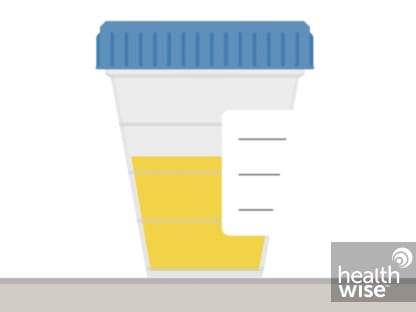Urine Test
Make an Appointment
Our team is here to help you make an appointment with the specialists that you need.
Urine Test
Test Overview
A urine test checks different components of urine, a waste product made by the kidneys. It checks the color, clarity (clear or cloudy), odor, concentration, and acidity (pH) of your urine. It also checks your levels of protein, sugar, blood cells, or other substances in your urine.
A urine test may be done to help find the cause of symptoms. The test can give information about your health and problems you may have.
The kidneys take out waste material, minerals, fluids, and other substances from the blood to be passed in the urine. Urine has hundreds of different body wastes. What you eat and drink, how much you exercise, and how well your kidneys work can affect what is in your urine.
More than 100 different tests can be done on urine.
Why It Is Done
A urine test may be done:
- To check for a disease or infection of the urinary tract. The urinary tract includes the kidneys, the tubes that carry urine from the kidneys to the bladder (ureters), and the bladder. It also includes the tube that carries urine from the bladder to outside the body (urethra).
- To check the treatment of conditions such as diabetes, kidney stones, a urinary tract infection (UTI), high blood pressure, or some kidney or liver diseases.
- As part of a regular physical examination.
How To Prepare
- Before the test, don't eat foods that can change the color of your urine. Examples of these include blackberries, beets, and rhubarb.
- Don't do heavy exercise before the test.
- Tell your doctor ALL the medicines, vitamins, supplements, and herbal remedies you take. Some may increase the risk of problems during your test. Your doctor will tell you if you should stop taking any of them before the test and how soon to do it.
How It Is Done
A urine test can be done in your doctor's office, clinic, or lab. Or you may be asked to collect a urine sample at home. Then you can take it to the office or lab for testing.
Clean-catch midstream urine collection
You will be asked to provide a clean-catch midstream urine sample. It collects urine without getting bacteria from the skin in the sample.
- Open the wipes. Remove the lid from the container, and set it down with the inner surface up.
- Wash your hands before you collect the urine.
- Clean your genitals with the provided wipes. If you have a vulva, hold the folds of skin or lips (labia) apart. Wipe the area from front to back. If you have a penis, use the wipes to clean the tip. If you have a foreskin, pull it back.
- Start to urinate into the toilet for a few seconds. Keep holding your skin away from the urine stream.
- After the urine has flowed for several seconds, place the collection container in the stream. Collect about 2 ounces (a quarter cup).
- Don't touch the container to your genitals.
- Finish urinating into the toilet or urinal.
- Carefully replace the lid on the container.
- Wash your hands.
Watch
Results
A urine test brings back many different types of results. These include color, clarity (is it clear or cloudy?), odor, and pH (how acidic or alkaline the urine is). Urine tests can also check for protein and sugar (glucose).
Results can be normal or abnormal. Your doctor will explain all the results to you and what they may mean for your health.
Color | Normal: Pale to dark yellow |
Abnormal:Many foods and medicines can affect the color of the urine. Urine with no color may be caused by long-term kidney disease or uncontrolled diabetes. Red urine can be caused by blood in the urine. | |
Clarity | Normal: Clear |
Abnormal:Cloudy urine can be caused by pus (white blood cells), blood (red blood cells), sperm, bacteria, yeast, crystals, mucus, or a parasite infection, such as trichomoniasis. | |
Odor | Normal: Slightly "nutty" odor |
Abnormal:Some foods (such as asparagus), vitamins, and antibiotics (such as penicillin) can cause urine to have a different odor. A sweet, fruity odor may be caused by uncontrolled diabetes. A urinary tract infection (UTI) can cause a bad odor. Urine that smells like maple syrup can mean maple syrup urine disease, when the body can't break down certain amino acids. | |
Specific gravity | Normal: 1.005–1.030 |
Abnormal:A very high specific gravity means very concentrated urine, which may be caused by not drinking enough fluid, loss of too much fluid (excessive vomiting, sweating, or diarrhea), or substances (such as sugar or protein) in the urine. Very low specific gravity means dilute urine, which may be caused by drinking too much fluid, severe kidney disease, or the use of diuretics. | |
pH | Normal: 4.6–8.0 |
Abnormal: Some foods (such as citrus fruit and dairy products) and medicines (such as antacids) can affect urine pH. A high (alkaline) pH can be caused by severe vomiting, a kidney disease, some urinary tract infections, and A low (acidic) pH may be caused by severe lung disease (emphysema), uncontrolled diabetes, aspirin overdose, asthma, severe diarrhea, dehydration, starvation, drinking too much alcohol, or drinking antifreeze (ethylene glycol). | |
Protein | Normal: None |
Abnormal:Protein in the urine may mean that kidney damage (such as caused by high blood pressure or diabetes), an infection, cancer, systemic lupus erythematosus (SLE), or glomerulonephritis is present. Protein in the urine may also mean that heart failure, leukemia, poison (lead or mercury poisoning), or preeclampsia (if you are pregnant) is present. | |
Glucose | Normal:1–15 milligrams per deciliter (mg/dL) or 60–830 micromoles per liter (mcmol/L) in a 24-hour sample. A one-time urine collection, if normal, will be negative for glucose. |
Abnormal:Intravenous (I.V.) fluids can cause glucose to be in the urine. Too much glucose in the urine may be caused by uncontrolled diabetes, an adrenal gland problem, liver damage, brain injury, certain types of poisoning, and some types of kidney diseases. Healthy pregnant women can have glucose in their urine, which is normal during pregnancy. | |
Ketones | Normal: None |
Abnormal:Ketones in the urine can mean uncontrolled diabetes, a very low-carbohydrate diet, starvation or eating disorders (such as anorexia nervosa or bulimia), alcohol use disorder, or poisoning from drinking rubbing alcohol (isopropanol). Ketones are often found in the urine when a person does not eat (fasts) for 18 hours or longer. This may occur when a person is sick and cannot eat or vomits for several days. Low levels of ketones are sometimes found in the urine of healthy pregnant women. | |
Microscopic analysis | Normal: Very few or no red or white blood cells or casts are seen. No bacteria, yeast cells, parasites, or squamous cells are present. A few crystals are normally seen. |
Abnormal: Red blood cells in the urine may be caused by kidney or bladder injury, kidney stones, a urinary tract infection (UTI), inflammation of the kidneys (glomerulonephritis), a kidney or bladder tumor, or systemic lupus erythematosus (SLE). White blood cells (pus) in the urine may be caused by a urinary tract infection, bladder tumor, inflammation of the kidneys, systemic lupus erythematosus (SLE), or inflammation in the vagina or under the foreskin of the penis. Depending on the type, casts can mean inflammation or damage to the tiny tubes in the kidneys, poor blood supply to the kidneys, metal poisoning (such as lead or mercury), heart failure, or a bacterial infection. Large amounts of crystals, or certain types of crystals, can mean kidney stones, damaged kidneys, or problems with metabolism. Some medicines and some types of urinary tract infections can also increase the number of crystals in urine. Bacteria in the urine mean a urinary tract infection (UTI). Yeast cells or parasites (such as the parasite that causes trichomoniasis) can mean an infection of the urinary tract. The presence of squamous cells may mean that the sample is not as pure as it needs to be. These cells do not mean there is a medical problem, but your doctor may ask that you give another urine sample. | |
Volume | Normal:800–2,500 milliliters (mL) per 24 hours. |
Credits
Current as of: April 30, 2024
Author: Ignite Healthwise, LLC Staff
Clinical Review Board
All Healthwise education is reviewed by a team that includes physicians, nurses, advanced practitioners, registered dieticians, and other healthcare professionals.
This information does not replace the advice of a doctor. Ignite Healthwise, LLC, disclaims any warranty or liability for your use of this information. Your use of this information means that you agree to the Terms of Use. Learn how we develop our content.
To learn more about Ignite Healthwise, LLC, visit webmdignite.com.
© 2024-2025 Ignite Healthwise, LLC.
This information does not replace the advice of a doctor. Ignite Healthwise, LLC, disclaims any warranty or liability for your use of this information. Your use of this information means that you agree to the Terms of Use. Learn how we develop our content.




